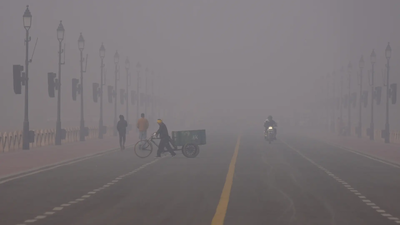
Visakhapatnam: A recent research study employing machine learning models to predict the air quality index (AQI) in Visakhapatnam achieved an impressive 0.9998 prediction accuracy with one of the ML algorithms. Another model achieved a 0.9936 prediction accuracy.
The researchers analysed open-source data from the Central Pollution Control Board (CPCB) spanning from 2017 to 2022 for the study.
By combining machine learning with historical pollutant data, this approach holds great potential for accurately forecasting future air quality. The study found that particulate matter (PM2.5 and PM10) had the most significant impact on the AQI in Visakhapatnam, followed by gaseous pollutants such as nitrogen dioxide and carbon monoxide. Interestingly, meteorological factors had minimal influence on AQI predictions.
The findings revealed that PM10 concentrations consistently exceeded 100 µg/m³ between January and March, and again from Oct to Dec during these five years. In contrast, during the Covid-19 lockdown in 2020, both PM2.5 and PM10 concentrations remained below 40 µg/m³ and 100 µg/m³, respectively, from April to September. These trends indicate that PM2.5 and PM10 levels were above the permissible limits during the first half of the year but fell within acceptable ranges afterward. The study also showed a strong correlation between AQI values and PM10 levels, highlighting that particulate matter plays a critical role in determining the AQI of Visakhapatnam.
Further analysis showed that the average PM2.5 and PM10 concentrations for the five-year period between July 2017 and Sept 2022 were 43 µg/m³ and 106 µg/m³, respectively. These levels were higher than the CPCB’s annual national ambient air quality standards for PM10, which is set at 60 µg/m³. The maximum recorded concentrations for PM2.5 and PM10 were 202 µg/m³ and 312 µg/m³, respectively, with both exceeding the permissible limits by 7.5% and 6%, respectively, over the past five years.
The researchers’ team included Gokulan Ravindiran, Gasim Hayder, Karthick Kanagarathinam, Avinash Alagumalai, and Christian Sonne , all from various institutions in India, Denmark, Canada, and Malaysia. The study wastitled ‘Air Quality Prediction by Machine Learning Models: A Predictive Study on the Indian Coastal City of Visakhapatnam’ was published in Elsevier’s Chemosphere journal.
“The elevated levels of particulate matter in Visakhapatnam are likely driven by several key factors. Coal combustion, particularly from the nearby coal-fired thermal power plant, is identified as one of the major contributors. These plants release pollutants such as arsenic, zinc, and chromium into the atmosphere. Being a coastal city, Visakhapatnam also experiences significant sea salt spray, which is a major source of chloride and sodium,” said Ravindiran, Hayder, Kanagarathinam, Alagumalai, and Sonne.
Visakhapatnam: A recent research study employing machine learning models to predict the air quality index (AQI) in Visakhapatnam achieved an impressive 0.9998 prediction accuracy with one of the ML algorithms. Another model achieved a 0.9936 prediction accuracy.
The researchers analysed open-source data from the Central Pollution Control Board (CPCB) spanning from 2017 to 2022 for the study.
By combining machine learning with historical pollutant data, this approach holds great potential for accurately forecasting future air quality. The study found that particulate matter (PM2.5 and PM10) had the most significant impact on the AQI in Visakhapatnam, followed by gaseous pollutants such as nitrogen dioxide and carbon monoxide. Interestingly, meteorological factors had minimal influence on AQI predictions.
The findings revealed that PM10 concentrations consistently exceeded 100 µg/m³ between January and March, and again from Oct to Dec during these five years. In contrast, during the Covid-19 lockdown in 2020, both PM2.5 and PM10 concentrations remained below 40 µg/m³ and 100 µg/m³, respectively, from April to September. These trends indicate that PM2.5 and PM10 levels were above the permissible limits during the first half of the year but fell within acceptable ranges afterward. The study also showed a strong correlation between AQI values and PM10 levels, highlighting that particulate matter plays a critical role in determining the AQI of Visakhapatnam.
Further analysis showed that the average PM2.5 and PM10 concentrations for the five-year period between July 2017 and Sept 2022 were 43 µg/m³ and 106 µg/m³, respectively. These levels were higher than the CPCB’s annual national ambient air quality standards for PM10, which is set at 60 µg/m³. The maximum recorded concentrations for PM2.5 and PM10 were 202 µg/m³ and 312 µg/m³, respectively, with both exceeding the permissible limits by 7.5% and 6%, respectively, over the past five years.
The researchers’ team included Gokulan Ravindiran, Gasim Hayder, Karthick Kanagarathinam, Avinash Alagumalai, and Christian Sonne , all from various institutions in India, Denmark, Canada, and Malaysia. The study wastitled ‘Air Quality Prediction by Machine Learning Models: A Predictive Study on the Indian Coastal City of Visakhapatnam’ was published in Elsevier’s Chemosphere journal.
“The elevated levels of particulate matter in Visakhapatnam are likely driven by several key factors. Coal combustion, particularly from the nearby coal-fired thermal power plant, is identified as one of the major contributors. These plants release pollutants such as arsenic, zinc, and chromium into the atmosphere. Being a coastal city, Visakhapatnam also experiences significant sea salt spray, which is a major source of chloride and sodium,” said Ravindiran, Hayder, Kanagarathinam, Alagumalai, and Sonne.






